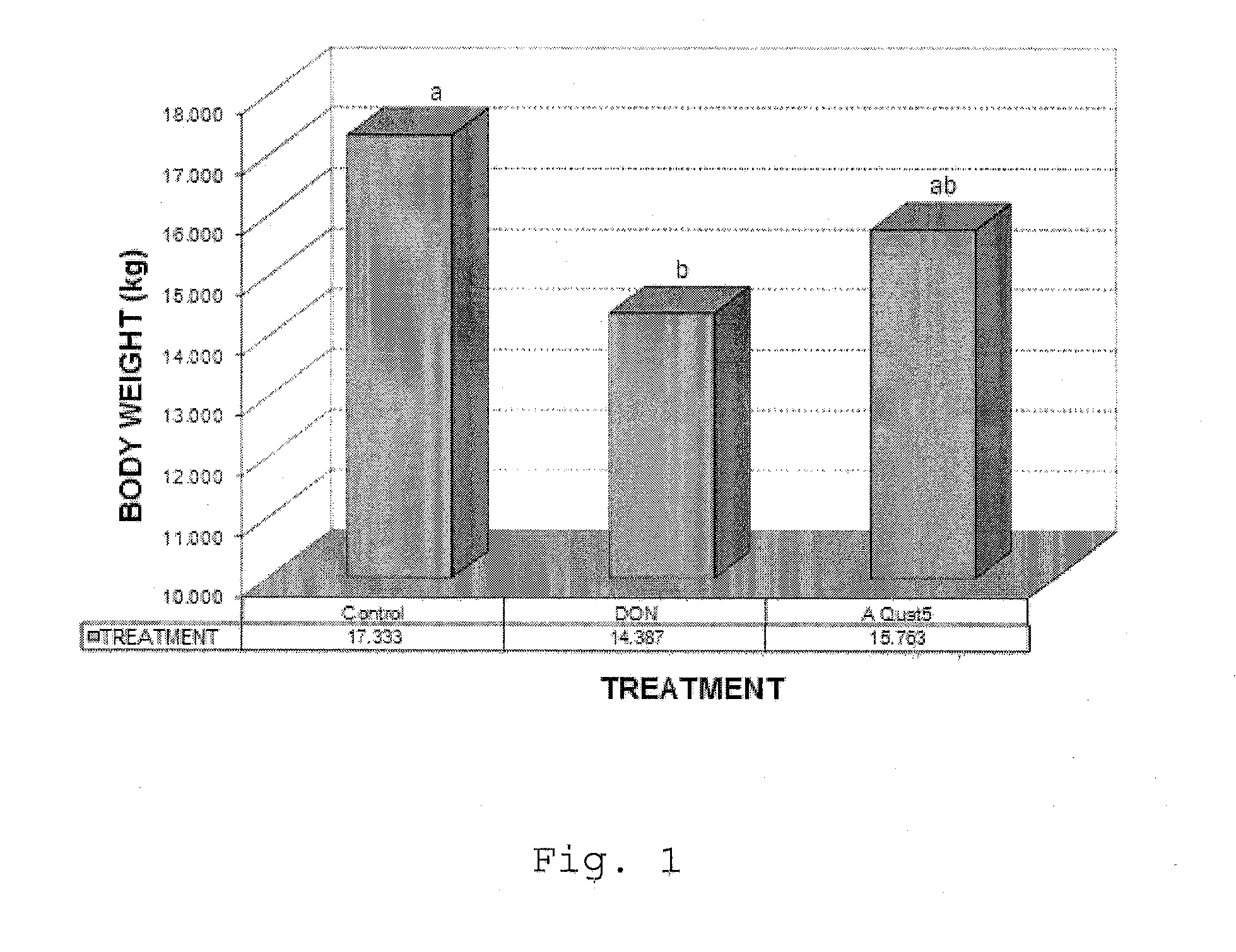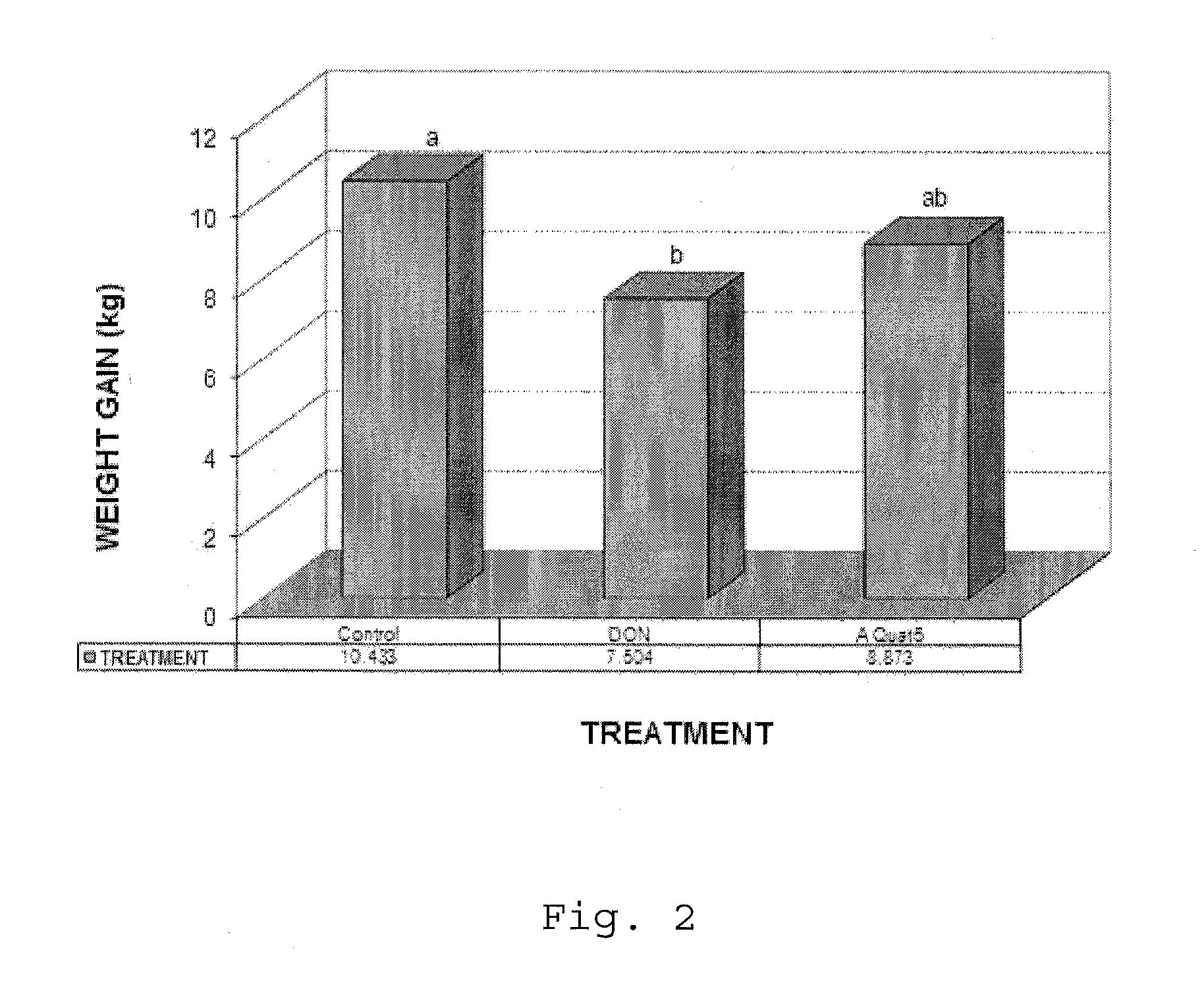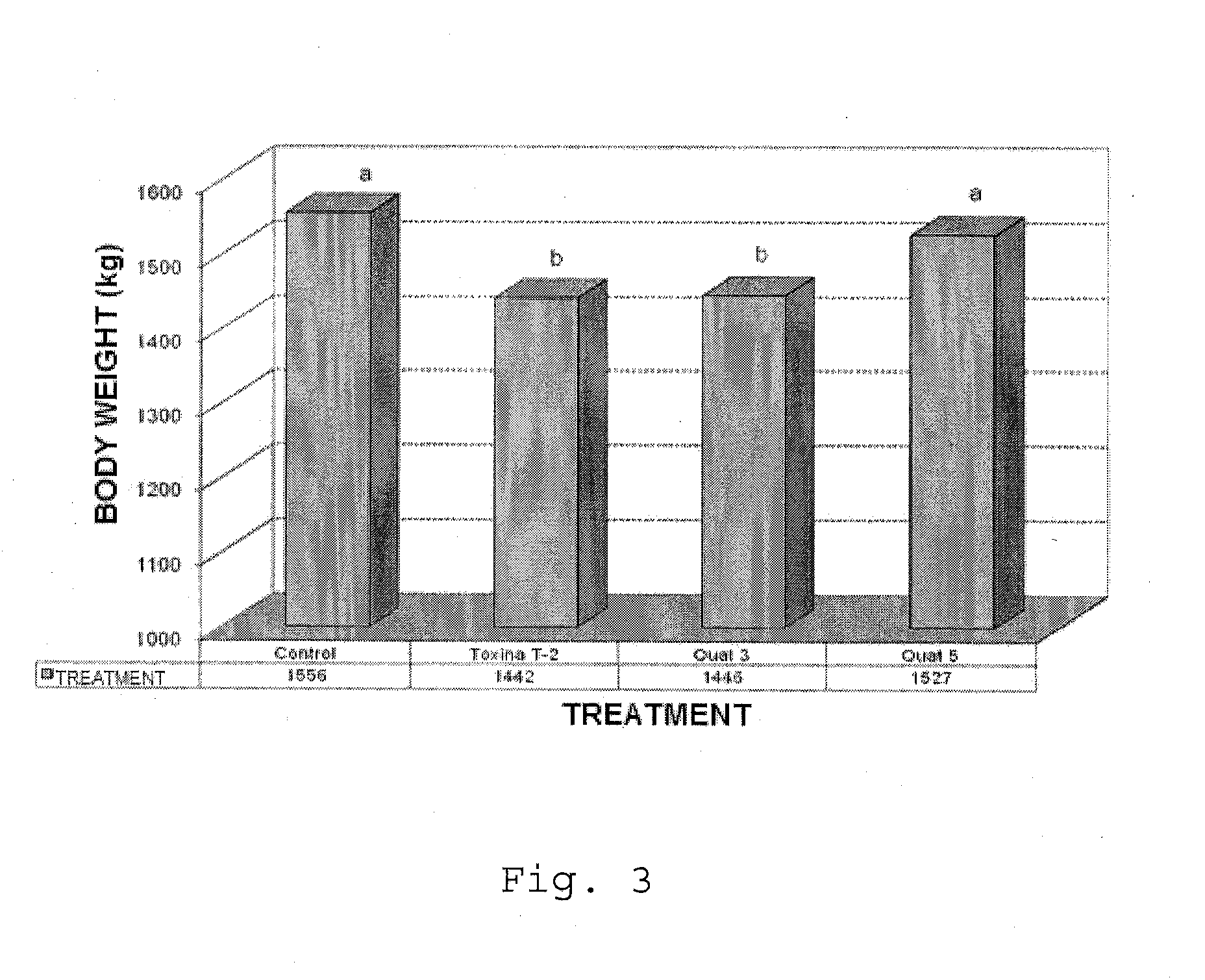Mycotoxin absorbent and the use thereof in balanced food for animals
a mycotoxin and absorbent technology, applied in the field of mycotoxin absorbents used in balanced feeds, can solve the problems of limited reduction of insufficient prevention of contamination, and inability of mycotoxin absorbents described in the previous art to reduce the bioavailability of trichothecenes, so as to prevent one or more adverse effects or symptoms
- Summary
- Abstract
- Description
- Claims
- Application Information
AI Technical Summary
Benefits of technology
Problems solved by technology
Method used
Image
Examples
example 1
Method of Synthesizing an Alkyl Phenol Ethoxylate Derivative
Method Using Triphenylphosphine
Raw Materials to Yield 49 g.
Triphenylphosphine, 60 g
Triethylamine 21 mL
[0069]Methylene chloride 300 mL
Bromine 12 mL
[0070]Nonyl phenol ethoxylate 10 moles of ethylene oxide 50 g dissolved in 50 mL of methylene chloride.
Hexane-ethyl acetate 1:1
Ethyl ether
[0071]Ethyl acetate.
Benzyldimethylamine 10.7 mL
Procedure
[0072]1. In a 1000-mL round-bottomed beaker equipped with a magnetic agitator, add 300 mL of methylene chloride and dissolve 60 g of triphenylphosphine and 21 mL triethylamine.[0073]2. Chill the mixture at 0° C. in an ice bath.[0074]3. Using an open system dropping funnel, slowly add 12 mL of bromine.[0075]4. Once the bromine has been added, allow mixture to react at the same temperature at constant agitation for 10 minutes[0076]5. Dissolve 50 g of surfacpol 9010 in 50 ml of methylene chloride and add to reaction beaker.[0077]6. Allow to react at 0° C. for an additional 30 minutes.[00...
example 2
Method of Synthesizing an Alkyl Phenol Ethoxylate Derivative
Method Using Tribromide Phosphorous
Raw Materials to Yield 38 g.
[0088]Nonyl phenol ethoxylate 10 moles ethylene oxide 50 g
Chloroform 100 mL
[0089]Tribromide phosphorous PBr3 4 mL.
Dimethylbenzilamine 10 mL
[0090]Solvents for elution, dichloromethane y methanol.
Procedure
[0091]1. In a round-bottomed 500-mL beaker dissolve 50 g of de nonyl phenol ethoxylate 10 in 150 mL of chloroform, bring solution to 0° C. in an ice-bath, and agitate for 15 minutes.[0092]2. Add 4 mL of PBr3 using a syringe, agitate the mixture at the same temperature for 1 hour.[0093]3. Agitate, maintaining at room temperature for 48 h.[0094]4. Evaporate the solvent at reduced pressure.[0095]5. Purify the crude mixture using chromatography in a column using the CH2Cl2 / MeOH 15:1 system as eluent.[0096]6. Transfer the resulting product to a round-bottomed 250 mL beaker and add 10 ml dimethylbenzilamine.[0097]7. First, heat the mixture at 120° C. for 24 hours, then...
example 3
Preparation of the Mycotoxin Adsorbent of the Invention
Raw Materials to be Used.
[0099]The characteristics of the organic compound used to treat the surface as shown in Table 2.[0100]The aluminum silicate base used is an aluminum silicate of the bentonite type, with a cation exchange capacity of 55 meq / 100 g.
TABLE 2Characteristics of the alkyl phenol ethoxylatederivative “QUAT 5” or “Q5”.QUATER-MOLECULARNARYTYPESTRUCTUREWEIGHTCHARGE“QUAT 5”EthoxylateAlkyl phenol857+1or “Q5”surfactantethoxylatederivativewith formula(Ia)
Formulation.
[0101]The initial experimental design was developed based on the substitution percentage of the cation exchange capacity of (CEC) of the aluminum silicate base. A percentage of the substitution from 60% to 120% of the CEC was taken.
Experimental Development of the Formulations.
Materials and Equipment.
[0102]1. Laboratory glassware.[0103]2. Magnetic agitator.[0104]3. Drying stove.[0105]4. Laboratory mortar or grinder.[0106]5. Sieve mesh 200.
Procedure.
[0107]The ...
PUM
| Property | Measurement | Unit |
|---|---|---|
| temperature | aaaaa | aaaaa |
| cation exchange capacity | aaaaa | aaaaa |
| temperature | aaaaa | aaaaa |
Abstract
Description
Claims
Application Information
 Login to View More
Login to View More - R&D
- Intellectual Property
- Life Sciences
- Materials
- Tech Scout
- Unparalleled Data Quality
- Higher Quality Content
- 60% Fewer Hallucinations
Browse by: Latest US Patents, China's latest patents, Technical Efficacy Thesaurus, Application Domain, Technology Topic, Popular Technical Reports.
© 2025 PatSnap. All rights reserved.Legal|Privacy policy|Modern Slavery Act Transparency Statement|Sitemap|About US| Contact US: help@patsnap.com



